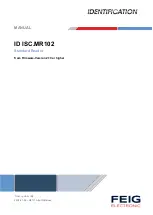
FOR MOBILE APPLICATIONS
W25Q256FV
Publication Release Date: May 13, 2012
- 80 - Preliminary - Revision M1
8.2.42
Program Security Registers (42h)
The Program Security Register instruction is similar to the Page Program instruction. It allows from one
byte to 256 bytes of security register data to be programmed at previously erased (FFh) memory locations.
A Write Enable instruction must be executed before the device will accept the Program Security Register
Instruction (Status Register bit WEL= 1). The instruction is initiated by driving the
/CS
pin low then shifting
the instruction code “42h” followed by a 24/32-bit address (A23/A31-A0) and at least one data byte, into
the DI pin. The
/CS
pin must be held low for the entire length of the instruction while data is being sent to
the device.
ADDRESS {A23/A31}-16
A15-12
A11-8 A7-0
Security Register #1
00h
0 0 0 1
0 0 0 0
Byte Address
Security Register #2
00h
0 0 1 0
0 0 0 0
Byte Address
Security Register #3
00h
0 0 1 1
0 0 0 0
Byte Address
The Program Security Register instruction sequence is shown in Figure 46. The Security Register Lock
Bits (LB3-1) in the Status Register-2 can be used to OTP protect the security registers. Once a lock bit is
set to 1, the corresponding security register will be permanently locked, Program Security Register
instruction to that register will be ignored (See 7.1.8, 8.2.25 for detail descriptions).
/CS
CLK
DI
(IO
0
)
Mode 0
Mode 3
0
1
2
3
4
5
6
7
Instruction (42h)
8
9
10
28
29
30
39
24-Bit Address
23
22
21
3
2
1
*
/CS
CLK
40
DI
(IO
0
)
41
42
43
44
45
46
47
Data Byte 2
48
49
50
52
53
54
55
20
72
51
39
7
6
5
4
3
2
1
0
0
31
0
32
33
34
35
36
37
38
Data Byte 1
7
6
5
4
3
2
1
*
Mode 0
Mode 3
= MSB
*
Data Byte 3
20
73
20
74
20
75
20
76
20
77
20
78
20
79
0
Data Byte 256
*
7
6
5
4
3
2
1
0
*
7
6
5
4
3
2
1
0
*
Figure 46. Program Security Registers Instruction (SPI Mode only)
32-Bit Address is required when the device is operating in 4-Byte Address Mode
















































